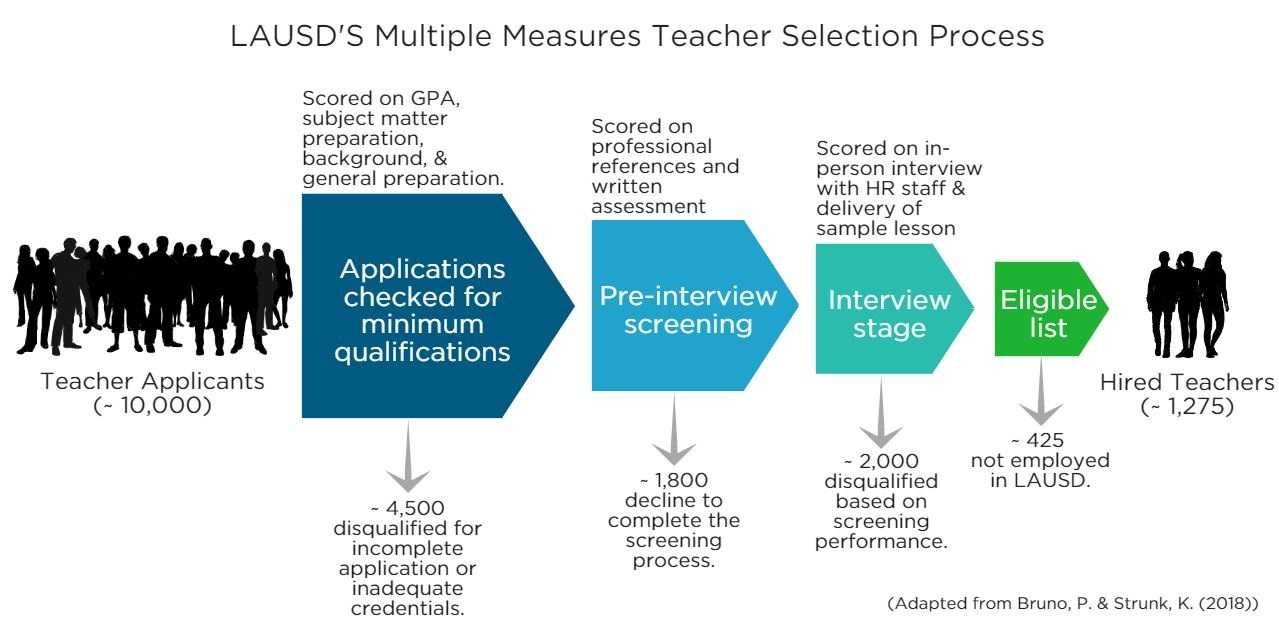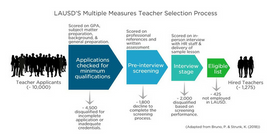It’s teacher hiring season, and school districts are out in full force working to recruit teachers. Data are increasingly available to help districts and principals become more strategic in teacher hiring, which is not to say districts avail themselves, but Los Angeles (LAUSD) is to seemingly good effect.
A new study from CALDER researchers Paul Bruno of the University of Southern California and Katharine Strunk of Michigan State University investigated the results of LAUSD’s new hiring system, adopted in the 2014-15 school year. They found evidence that the system is effective in screening for teacher quality overall and predicting specific desired outcomes.
Before 2014, LAUSD used a hiring system familiar to anyone in human resources—the (not particularly useful) interview. The new “Multiple Measures” process switched things up by creating a standardized system in which applicants are scored on eight areas:
- Undergraduate GPA
- Score on the subject matter licensure test
- Background (e.g., prior non-teaching LAUSD, military, or Teach for America experience and/or a graduate degree);
- General preparation (e.g., attending a highly ranked university, evidence of teaching effectiveness in a past position, or a major in their subject)
- Professional references
- Writing task
- Sample lesson plan and delivery
- Interview
Successful applicants must achieve both passing scores in each of these eight areas and a minimum overall.

The results found the screening process to be pretty effective. Higher overall scores were associated with larger teacher contributions to student achievement in both ELA and math, significantly lower odds of a teacher receiving an unsatisfactory evaluation rating, and fewer teacher absences each year. However, it wasn’t able to predict if a teacher were more or less likely to stay or move schools (contrary to a system in Spokane, WA which did do so).
Different scores in each area were associated with different outcomes. For example, applicant scores on the sample lesson and the area entitled ‘general preparation’ (such as attending a highly ranked university) most strongly predicted student achievement in ELA. Teacher evaluation ratings, on the other hand, were predicted by the scores from the sample lesson, undergrad GPA, and subject matter licensing test. Teacher attendance was most strongly predicted by professional references.
Consistent with a large body of research, neither the possession of a graduate degree nor the interview score were predictive of any of these positive teacher outcomes.
One factor notably missing from this study was the screening tool’s impact, if any, on teacher diversity.
Perhaps not all school districts should adopt as complex a system as LAUSD (the second largest school district in the nation), but there is genuine value in making use of available data during the hiring process. Considered strategically, a rigorous screening process can help to ensure that districts are making the right choices about who goes into the classroom.
More like this

Are the teachers alright? A new survey offers some answers

From pensions to performance: A new blueprint for teacher compensation

Does paid parental leave for teachers pay off?


